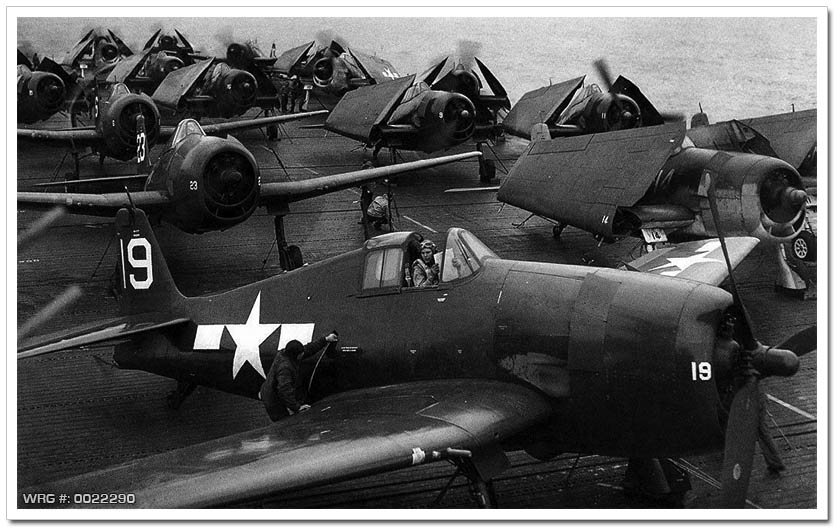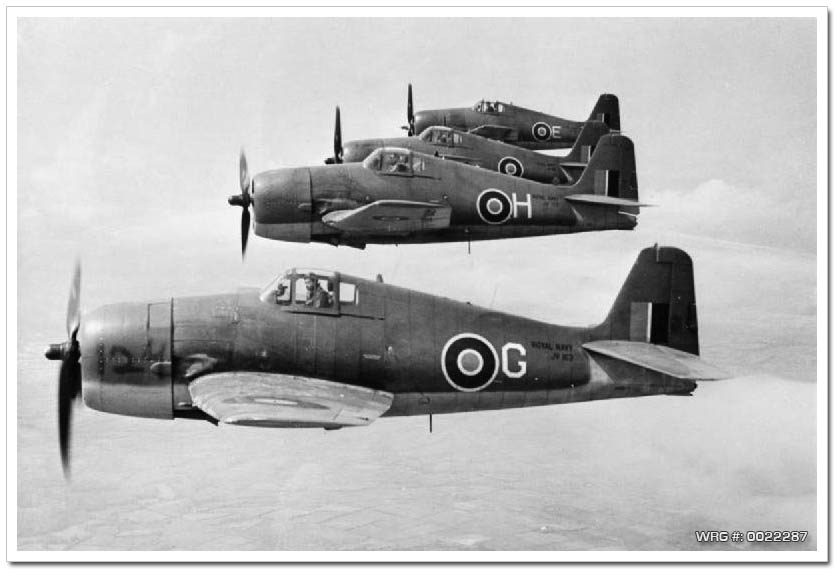U.S. NAVAL AVIATION RESOURCE CENTER > FIGHTERS > HELLCAT > PREVIOUS PAGE
Operational History
The U.S. Navy much preferred the more docile flight qualities of the F6F compared with the Vought F4U Corsair, despite the superior speed of the Corsair. This preference was especially noted during carrier landings, a critical success requirement for the Navy, in which the Corsair was fundamentally flawed in comparison. The Corsair was thus released by the Navy to the Marine Corps who without the need to worry about carrier landings, used the Corsair to immense effect in land-based sorties. The Hellcat remained the standard USN carrier-borne fighter until the F4U series was finally cleared for U.S. carrier operations in late-1944 (the carrier landing issues had by now been tackled largely thanks to use of Corsair by the Royal Navy Fleet Air Arm). In addition to its good flight qualities, the Hellcat was easy to maintain and had an airframe tough enough to withstand the rigors of routine carrier operations. Like the Wildcat, the Hellcat was designed for ease of manufacture and ability to withstand significant damage.

[Source: U.S. Navy]
When trials were flown against a captured Zero Type 52, they showed that the Hellcat was faster at all altitudes. The F6F outclimbed the Zero marginally above 14,000 ft and rolled faster at speeds above 235 mph. The Japanese fighter could out-turn its American opponent with ease at low speed and enjoyed a slightly better rate of climb below 14,000 ft.
Hellcats were the major U.S. Navy fighter type involved in the Battle of the Philippine Sea, where so many Japanese aircraft were shot down that Navy aircrews nicknamed the battle "the Great Marianas Turkey Shoot". The F6F accounted for 75% of all aerial victories recorded by the U.S. Navy in the Pacific. Radar-equipped Hellcat night fighter squadrons appeared in early 1944.
Sortie, kill and loss figures
U.S. Navy and Marine F6F pilots flew 66,530 combat sorties and claimed 5,163 kills (56% of all U.S. Navy/Marine air victories of the war) at a recorded cost of 270 Hellcats in aerial combat (an overall kill-to-loss ratio of 19:1 based on claimed but not confirmed kills). The aircraft performed well against the best Japanese opponents with a claimed 13:1 kill ratio against the A6M Zero, 9.5:1 against the Nakajima Ki-84, and 3.7:1 against the Mitsubishi J2M during the last year of the war. The F6F became the prime ace-maker aircraft in the American inventory, with 305 Hellcat aces. The U.S. successes were not only attributed to superior aircraft, but also from 1942 onwards, they faced increasingly inexperienced Japanese aviators as well as having the advantage of increasing numerical superiority. In the ground attack role, Hellcats dropped 6,503 tons (5,899 tonnes) of bombs.

Pilot use the wing to escape his burning Hellcat after landing aboard the USS Lexington, 1945
[Source: U.S. Navy]
British Fleet Air Arm
The British Fleet Air Arm (FAA) received 1,263 F6Fs under the Lend-Lease Act; initially it was known as the Grumman Gannet Mark I. The name Hellcat replaced it in early 1943 for the sake of simplicity, the Royal Navy at that time adopting the use of the existing American naval names for all the U.S.-made aircraft supplied to it, with the F6F-3 being designated Hellcat F Mk.I, the F6F-5, the Hellcat F Mk.II and the F6F-5N, the Hellcat NF Mk.II. They saw action off Norway, in the Mediterranean and in the Far East. A number were fitted with photographic reconnaissance equipment similar to the F6F-5P, receiving the designation Hellcat FR Mk.II. The Pacific War being a naval war, the FAA Hellcats primarily faced land based aircraft in the European and Mediterranean Theaters, and as a consequence experienced far fewer opportunities for air-to-air combat than their USN/Marines counterparts; they claimed a total of 52 enemy aircraft kills during 18 aerial combats from May 1944 to July 1945. 1844 Naval Air Squadron, on board HMS Indomitable of the British Pacific Fleet was the highest scoring unit, with 32.5 kills.

Royal Navy Grumman Hellcat F.I fighters of No. 1840 Naval Air Squadron based at
Royal Naval Air Station Eglinton, Northern Ireland, June 23, 1944.
[Source: Royal Navy]
Postwar service:
Postwar, the Hellcat was succeeded by the F8F Bearcat, which was smaller, more powerful (powered by uprated Double Wasp radials) and more maneuverable, but entered service too late to see combat in World War II. The Hellcat was used for second-line USN duties, including training. In late 1952, Guided Missile Unit 90 used F6F-5K drones, each carrying a 2000 lb bomb, to attack bridges in Korea; flying from USS Boxer, radio controlled from an escorting AD Skyraider. The French Aéronavale was equipped with F6F-5 Hellcats and used them in Indochina. The Uruguayan Navy also used them until the early 1960s.
The F6F-5 subtype also gained fame as the first aircraft used by the U.S. Navy's Blue Angels official flight demonstration team at its formation in 1946.
Source:
Wikipedia
U.S. NAVAL AVIATION RESOURCE CENTER > FIGHTERS > HELLCAT > PREVIOUS PAGE
